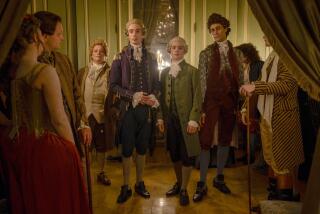The Boxer Rebellion : Silks. Pastels. Metallic thongs! More and more men are forsaking their plain white underwear for something a lot racier. These are not your father’s skivvies.
- Share via
There is a grand tradition of men leaving their underwear on the floor. Our fathers did it, and their fathers before them.
Perhaps this slovenliness is genetic. Perhaps it is a subtle declaration of machismo . Men like to think of themselves as builders of great things in steel and triplicate. Underwear are not worth stopping, much less stooping, to pick up.
For the record:
12:00 a.m. July 2, 1993 For the Record
Los Angeles Times Friday July 2, 1993 Home Edition View Part E Page 3 Column 3 View Desk 1 inches; 19 words Type of Material: Correction
Museum curator--Richard Martin is a curator at the Metropolitan Museum of Art. A May 28 View story incorrectly stated his affiliation.
But something has gone amiss in the ways of men. The age of sensitivity--unsated by bonding and support groups--has brought us a whole new way of thinking about skivvies.
Department stores that once stocked row after row of white briefs, as orderly as any king’s regiment, have blossomed in pastels and fluorescents. Thongs, minuscule garments of Lycra, have entered the land of cotton. The trusty $10 three-pack has been joined by designer prints that drape from hangers.
“Most men never dreamed they could go out and spend $75 for a pair of boxers,” said David Miller, manager of the Boxer Bay store in the Beverly Center. “Men, for the most part, have never stopped to consider the possibilities of their underwear wardrobe.”
Their underwear wardrobe ? Our ancestors wore the same six pairs of boxers, over and over, until the material fell gray and threadbare.
They most certainly did not flip through racks of $50 “surface-sanded,” limited-edition, charmeuse silk shorts. These Nicole Miller boxers--among the hottest new items in men’s furnishings--feature the same prints the designer uses for her neckties.
Nor did they take a cue from someone like rapper Marky Mark, who flaunts Calvin Klein’s curious inbreed, the long and clingy and popular “boxer brief.” Even when he pulls on jeans, Mark rapper lets his elastic waistband show. (Some of our forefathers did likewise, but not on purpose.)
These styles are no fad. Men’s underwear awoke in the mid-1980s and shows no sign of retreat. And this fashion twitch spans all ages. A Bullock’s salesman explains: “We get 70-year-old men who buy thongs.”
What drives men to such brevity? It is the Zeitgeist of unmentionables, fashion experts claim, a shift in sensibilities fueled by health clubs, R-rated movies and Calvin Klein billboards.
“Men have an ability to look at their bodies,” said Richard Martin, curator of the Museum of Modern Art’s costume institute. “It is now acceptable for the male to think of himself as a sexual object. So there is a sense that underwear is a style choice.”
Industry old-timers insist that basic whites still account for the vast majority of the $1 billion that Americans spend on men’s underwear each year. The traditional brands--Hanes, Fruit of the Loom and Jockey--still rule. “Some men wear only plain boxers, some men wear only plain briefs,” says a salesman at Nordstrom, which does not carry anything as salacious as thongs.
But with manufacturers like Klein and Joe Boxer, in San Francisco, showing annual sales increases as large as 50%, no one is ignoring the newcomers.
Says Nicholas Graham, the man behind Boxer’s irreverent line: “I think the whole category of men’s underwear in the mid-1980s became an alternative to the plain, white, stupid underwear that we’ve come to know and love and that we now use to wax our cars.”
This boxer rebellion may have begun as early as 1934, when Clark Gable took his shirt off to reveal a bare chest in the film “It Happened One Night.” Undershirt sales plummeted overnight, rocking the industry. Yet, by showing heretofore unseen skin, Gable set a precedent for today’s styles.
“Suddenly,” Martin explains, “the male body could be seen.”
World War II gave us perhaps the first colored boxer shorts, though there was just one color and it was olive drab. But technology exerted itself in the 1960s. As the wonders of science gave us more and more synthetic fabrics, stores began selling undies made of mesh and stretch nylon.
“It was like psychedelics and tie-dye,” says Scott Flynn, a vice president at Jockey. “The younger generation was rebellious and wanted to be different.”
Ultimately, disco is to blame. (Disco should be blamed, at least in part, for anything wrong with or even questionable about modern society.) When American men took to wearing skintight polyester, they also took to fretting over panty lines. Bikini briefs became popular and, the next thing you knew, Jim Palmer was showing up in magazine ads wearing next to nothing.
Haute couture saw its chance.
Calvin Klein jumped in first, one leg at a time. His briefs remained classic white, but his advertisements showed bronze men lounging in lurid poses. This, you just know, was how Romans spent their leisure time before the fall.
Was Klein an opportunist, quick to tidy up after the sexual revolution? Or did he merely intend to shock?
“People, when they see it’s Calvin Klein, they look for things,” the designer told Adweek magazine in 1985. “There’s always a reaction, and that’s what I want.”
Graham stumbled in with Joe Boxer at roughly the same time. His style eschewed sexy for silly, with shorts covered in mooseheads and spaceships and ants. One version depicted a gas-station attendant asking “Check Your Underwear?” This line boldly challenged the notion that only oldsters wear boxers.
“We were too stupid to know what we were doing,” Graham says.
The traditional companies have waded in, too, if more cautiously. Hanes uses Michael Jordan to advertise its stretch undies. Jockey peddles fire-engine-red thongs in department stores. Even lingerie manufacturers such as Victoria’s Secret have gotten into the act, adding shiny men’s items. This provided another clue to the shift: the majority of men’s underwear is bought by women.
Some estimates suggest that wives and girlfriends account for 70% of nationwide sales. So designers figured that a good way to get a man’s attention is to appeal to his mate. “Women have always known how nice it is to wear silk,” says Miller, at Boxer Bay . “They’ll buy it for their husband, and they’re not price resistant.”
And men--the new breed who want that slinky, silky feeling, who look at their bodies and see objects of beauty--are converting. But at what price?
“I’ve had them come in looking for basic Calvin Klein briefs,” Miller says. “I showed them around and they went from a $9 brief to a $30 brief, and will probably never look at Calvin again.”
So it seems a bargain when you find a pair of polka-dotted Ralph Lauren boxers (don’t call them underpants--they are “gentleman’s underwear”) at Nordstrom for $20. Or the Jockey thong for $7, though you’re getting what amounts to half a pair for that price.
Joe Boxer’s latest line runs $15 each. One is covered with Marilyn Monroe faces. Another reads “NO, NO, NO” until you turn out the lights, when glow-in-the-dark letters urge “YES, YES, YES.”
And at The Broadway in West Covina, weightlifters pay $40 for Calvin Klein body underwear, a sort of unitard for men.
“It’s expensive,” says Terry Turgon, a saleswoman. “Sometimes they wait for a sale.”
Men? Waiting for a sale? Somewhere our grandfathers are twisting in their shorts.
A BRIEF HISTORY: How underwear unfolds on screen and in print







